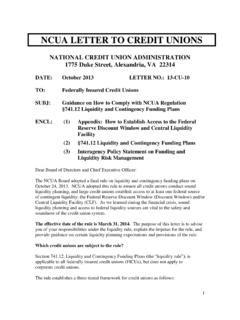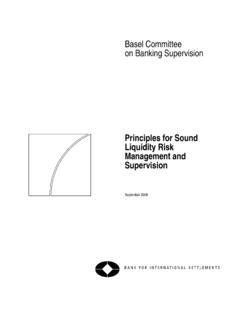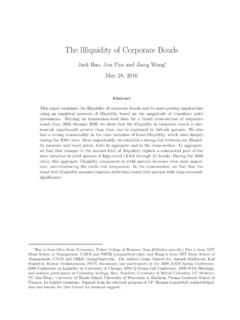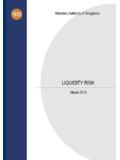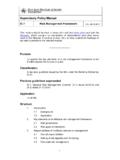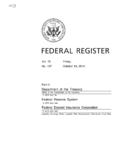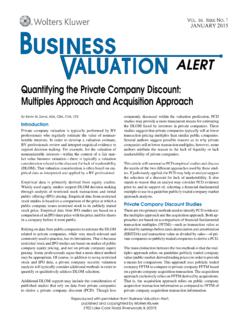Transcription of THINKING BEYOND BASEL III: NECESSARY …
1 OECD Journal: Financial Market Trends Volume 2010 Issue 1 OECD 2010 Pre-publication version 1 THINKING BEYOND BASEL III: NECESSARY solutions FOR CAPITAL AND liquidity Adrian Blundell-Wignall and Paul Atkinson* In previous studies, the OECD has identified the main hallmarks of the crisis as too-big-to-fail institutions that took on too much risk, insolvency resulting from contagion and counterparty risk, the lack of regulatory and supervisory integration, and the lack of efficient resolution regimes. This article looks at how the BASEL III proposals address these issues, helping to reduce the chance of another crisis like the current one. The BASEL III capital proposals have some very useful elements, notably a leverage ratio, a capital buffer and the proposal to deal with pro-cyclicality through dynamic provisioning based on expected losses.
2 However, this report also identifies some major concerns. For example, BASEL III does not properly address the most fundamental regulatory problem that the promises that make up any financial system are not treated equally. This issue has many implications for the reform process, including reform of the structure of the supervision and regulation process and whether the shadow banking system should be incorporated into the regulatory framework and, if so, how. Finally, modifications in the overall risk-weighted asset framework are suggested that would deal with concentration issues. * Adrian Blundell-Wignall is Special Advisor to the Secretary General of the OECD for Financial Markets and Deputy Director of the OECD Directorate for Financial and Enterprise Affairs, and Paul Atkinson is a Senior Research Fellow at Groupe d Economie Mondiale de Sciences Po, Paris.
3 The article has benefitted from comments by Carolyn Ervin and other OECD staff members. All remaining errors are those of the authors. This work is published on the responsibility of the Secretary-General of the OECD. The opinions expressed and arguments employed herein are those of the authors and do not necessarily reflect the official views of the Organisation or of the governments of its member countries. THINKING BEYOND BASEL III: NECESSARY solutions FOR CAPITAL AND liquidity 2 OECD JOURNAL: FINANCIAL MARKET TRENDS VOLUME 2010 ISSUE 1 OECD 2010 A. Introduction The consultative documents entitled Strengthening the Resilience of the Banking Sector (henceforth referred to as BASEL III') and International Framework for liquidity Risk Measurement, Standards and Monitoring are a part of the BASEL Committee s ongoing work in response to the crisis.
4 This paper reviews the proposal, and asks whether they provide a basis for reform that will help to avoid crises in the future. Sudden changes in asset quality and value can quickly wipe out bank capital. Where short-term wholesale liabilities fund longer-term assets, failure to roll over short-term financial paper, or a run on deposits, can force de-leveraging and asset sales. Banking crises associated with such changes are often systemic in nature, arising from the interconnectedness of financial arrangements: banks between themselves, with derivative counterparties and with direct links to consumption and investment spending decisions. In history, banking crises have been associated with major economic disruption and recessions. It is for this reason that policy makers regulate the amount of capital that banks are required to hold, and require high standards of corporate governance, including liquidity management, accounting, audit and lending practices.
5 This paper first looks at the BASEL system historically, and then summarises all of the key problems with it all of which contributed in some part to its failure to help to avoid the recent global financial crisis. In section C the paper summarises the recent BASEL III proposals, and section D critically analyses them. Section E sets out the liquidity proposals and a brief critique. Finally section F provides a summary and draws implications for the financial reform process. B. The BASEL system historically BASEL capital weighting in place from 1992 Capital regulations under BASEL I came into effect in December 1992 (after development and consultations since 1988). The aims were: first, to require banks to maintain enough capital to absorb losses without causing systemic problems, and second, to level the playing field internationally (to avoid competitiveness conflicts).
6 A minimum ratio of 4% for Tier 1 capital (which should mainly be equity less goodwill) to risk-weighted assets (RWA) and 8% for Tier 1 and Tier 2 capital (certain subordinated debt etc).1 The BASEL I risk weights for different loans are shown on the left side of Table 1. THINKING BEYOND BASEL III: NECESSARY solutions FOR CAPITAL AND liquidity OECD JOURNAL: FINANCIAL MARKET TRENDS VOLUME 2010 ISSUE 1 OECD 2010 3 A revised framework known as BASEL II was released in June 2004 (BCBS, 2004) after many issues with BASEL I, most notably that regulatory arbitrage was rampant (Jackson, 1999). BASEL I gave banks the ability to control the amount of capital they required by shifting between on-balance sheet assets with different weights, and by securitising assets and shifting them off balance sheet a form of disintermediation.
7 Banks quickly accumulated capital well in excess of the regulatory minimum and capital requirements, which, in effect, had no constraining impact on bank risk taking. BASEL I and II fail to stop global crisis As the centrepiece for capital regulation to avoid crises the BASEL approach has failed in its 1st and 2nd formulations and the world is still dealing with the after effects of the greatest financial crisis since the Great Depression. Pillar 1 of the BASEL II system defines minimum capital to buffer unexpected losses. Total RWA are based on a complex system of risk weighting that applies to credit , market (MR) and operational risk (OR), which are calculated separately and then added: RWA= { (OR+MR) + *SUM[w(i)A(i)]} (1) where: w(i) is the risk weight for asset i; and A(i) is asset i; OR and MR are directly measured and grossed up by for 8% equivalence; and credit risk is the sum of the various asset classes, each weighted by its appropriate risk weight.
8 A scaling factor applied to this latter term, estimated to be on the basis of QIS-3 data (but subject to change), was envisaged for the transition period, which was supposed to start for most countries in January 2008. Banks were to be able to choose between: first, a simplified approach (for smaller institutions without the capacity to model their business in risk terms) by using the fixed weights shown in column two of Table 1; second, an approach based on external ratings (shown in the column three in Table 1); and third, an internal ratings-based (IRB) approach for sophisticated banks, driven by their own internal rating models (see the right side of Table 1). BASEL II, more detailed, reduced weights The simplified BASEL II approach is more granular than BASEL I, but retains its basic features.
9 It is striking in light of the financial crisis that the simplified approach shows the BASEL Committee cutting the risk weight to mortgages by some 30% (from 50% to 35%) and much more in the sophisticated version. The weight for lending between banks was only 20% under BASEL 1, kept the same under the simplified BASEL II, and is likely to be cut by 20 to 30% under the sophisticated approach. Complex modelling The IRB approach requires banks to specify the probability of default (PD) for each individual credit, its loss-given-default (LGD), and the expected exposure at default (EED). This requires highly-complex modelling and aggregation, and offers banks with the NECESSARY expertise the possibility of deriving more risk-sensitive weights. This approach requires the approval of the bank s supervisor.
10 THINKING BEYOND BASEL III: NECESSARY solutions FOR CAPITAL AND liquidity 4 OECD JOURNAL: FINANCIAL MARKET TRENDS VOLUME 2010 ISSUE 1 OECD 2010 Table 1. BASEL I and BASEL II risk weights and commentary Risk Weights Under BASEL I and BASEL II (Pillar I), % BASEL IBASEL IIBASEL IIBASEL II Adva nce d: Inte rna l Ra tings Ba se d (IRB) SimplifiedStandardised2004-05 QIS 42004-05 QIS 4 Standardised based onAvg % chgMedian %Externalin in tingsMRCMRCBa se l II Adva nce d IRBMost Government/central bank0000 Comes close to letting banks set their ownAAA to AA-0 Pillar 1 capital, with supervisory + to A-20 Risk weights depend on internal estimatesBBB+ to BBB-50of a loan's probability of default; loss-given-BB+ to B- (& unrated)100default; exposure to loss. These are basedBelow B-150on the banks' own complex risk models,Other public (supervisors discretion)0-50000relying on subjective inputs and often onCla ims on ( OTC illiquid securities)M o st OECD Ba n ks & S e cu r i ti e s fi r m s2020< to AA-2020 Pillar 2 provides for supervisory + to A-2050 With stress testing, and guidance from BBB+ to BBB- (& unrated)2050supervisors, banks can be made to holdBB+ to B-50100capital for risks not adequately capturedBelow B-150150under Pillar si d e n ti a l M o r tg a g e s-fu l l y se cu r e 3 is disclosure and market disciplineRetail Lending (consumer)1007575( to )( to ) which relies on some notion of market Corpora te & Comme rcia l RE100100( )( to ) efficiency.










